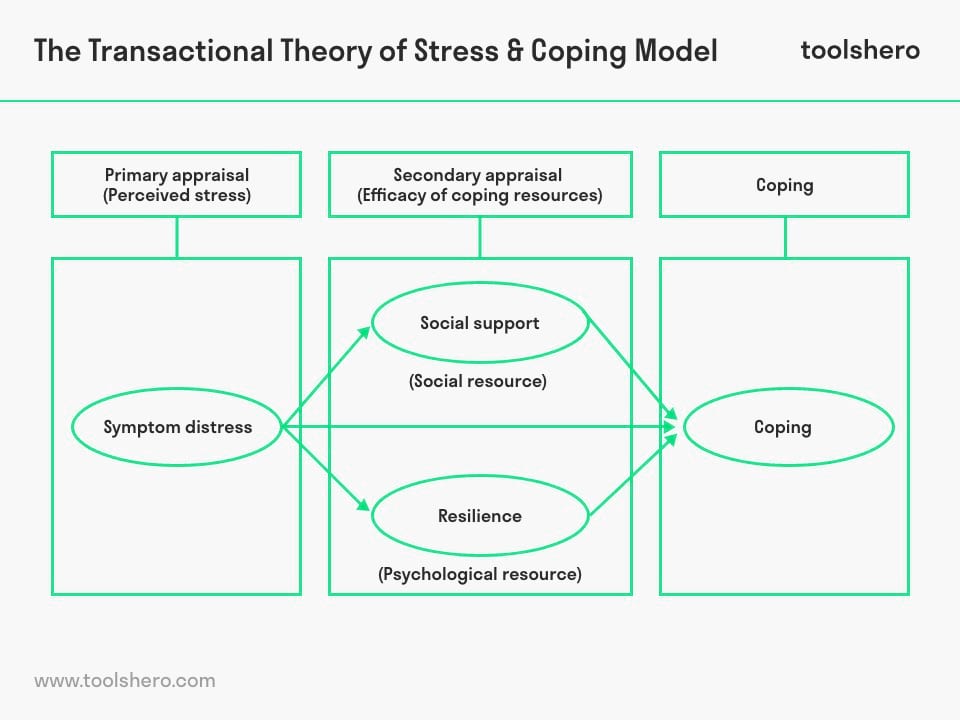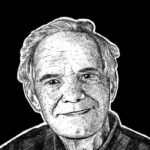Transactional theory of stress and coping

Transactional Theory of Stress and Coping (TTSC): this article explains the Transactional Theory of Stress and Coping (TTSC) as used in practice. After reading this article, you will understand the basis of this powerful psychology tool.
What is the Transactional Theory of Stress and Coping (TTSC)?
The Transactional Theory of Stress and Coping (TTSC) is a framework which focuses on assessments in order to evaluate damages, threats and challenges. The product or the result of this evaluation is a description of the process used to handle stressful situations.
Stress is experienced in different ways. Some of these ways include thoughts, feelings, behaviours and emotions. These are usually caused by external stress factors. The level of stress a person experiences depends on how the situation is perceived.
Transactional Theory of Stress and Coping (TTSC) by Lazarus and Folkman
The Transactional Theory of Stress and Coping (TTSC) is the result of research conducted by Dr. Richard Lazarus. This research began in 1966. He continued on with his research and published various books and articles. For this, he has worked with other scientists, including Dr. Susan Folkman.
Causes of stress on the workfloor
Work-related stress is a big problem all over the world. Not only does it negatively affect the health of employees, it also affects the productivity of organisations as a whole. Work-related stress arises when what has to be done is not in balance with the available capacity, among other things. But more on this later.
Other sources of work-related stress include conflicts with colleagues or other people concerned, constant changes or, for example, dismissal. Potential stressors within a company, or the most common problems are identified as:
- Conflicts about roles
- Both personal and professional relationships in the workplace
- Work environment
- Poor management
- Organisational cultures
- Trauma
- Absence of support
- Job requirements
The symptoms of work-related stress and non-work-related stress are similar. Some of these include:
- Sleep problems, insomnia and anxiety
- Headaches, muscle aches, heart palpitations
- Psychological symptoms, such as depression, anxiety, despondency, irritability, pessimism
- Cognitive problems such as reduced ability to concentrate or difficulties in effective decision-making
- Loss of productivity
- Reduced work performance
- Lack of interest and isolation
The core of Transactional Theory of Stress and Coping (TTSC)
Lazarus and Folkman’s theory evaluates how significant life events, as well as everyday affairs, affect emotions. The main focus of the theory lies on cognitive assessment and dealing with stress (coping).
The definition of Transactional Theory of Stress and Coping (TTSC)
Cognitive assessment consists of an initial primary assessment, a secondary assessment, and potentially, a reassessment. The secondary assessment entails assessing the possibilities in a certain situation and the person’s ability to deal with this.
Coping follows on from the assessment described above, and can affect a change in the relationship between a person and their environment, or the level of emotional stress they are experiencing. Factors which influence both the coping and judging mechanisms are personality traits, symptoms of depression, and social influences.
To understand the power of the Transactional Theory of Stress and Coping (TTCS), it is important to first understand what stress is exactly, and how research on stress has evolved over the years. For this reason, in the next section of this article, stress is defined in three ways: stress as a reaction, stress as a stimulus, and stress as a transaction.
1. Stress as a reaction
In 1956 Hans Selye determined that stress can be a reaction. In his stress model, he describes how stress creates a physiological pattern. He documented this pattern in the General Adaptation Syndrome model. This model describes stress as a reaction based on three concepts.
- Stress is a defence mechanism
- Stress arises when there is danger, resistance or exhaustion
- Stress, if long-term, can lead to adaption diseases and even death
After that, Selye discovered that stress can lead to both positive and negative outcomes based on its cognitive interpretation. Therefore, stress can be experienced in both a positive and negative way.
2. Stress as a stimulus
The theory behind the concept of stress as a stimulus was introduced by Holmes and Rahe in the 1960s. They saw stress as an important event or change which requires an adjustment or a response.
Following this, Rahe and Holmes created the Social Readjustment Rating Scale (SRRS). This scale consists of 42 life events which are ranked based on the estimated degree of influence these events have on a person.
Examples of these events include marriage, divorce, relocation, or the loss or change of a job or loved one. Holmes and Rahe assumed that stress was a variable in the comparison between stress and health. Even though some correlations emerged, the extent to which stress affects health was not clearly definable. The theory about stress as a stimulus can be summarised as follows:
- Change is stressful
- The degree to which life events require adjustment is the same for everyone.
- There is a threshold when it comes to adjustment and stress beyond which becoming sick is a consequence.
3. Stress as a transaction
Several studies had been conducted on stress before Lazarus and Folkman developed their Transactional Theory of Stress and Coping (TTCS). They mainly did so in an attempt to explain stress as a dynamic process.
The theory describes stress as a product of interactions between a person and their environment. When we talk about a person, we talk about multiple systems within a person: the cognitive system, physiological state, affective system, psychological system and the neurological system.
Winter hardiness
Attention to the Lazarus and Folkman theory was heightened when Suzanne Kobassa used the concept of winter hardiness in 1979. Winter hardiness, or also called cognitive or psychological hardiness, is a personality style.
Kobassa described a pattern of personality traits which distinguished between managers and executives who remained healthy while under stress, and those who developed health problems.
Evaluation levels for the assessment of stress according to Lazarus
Lazarus discovered that each person assesses a situation in a different way, and hence also the stress and threat which arise from it. He distinguished between three different levels.
Level 1: Primary appraisal
According to Lazarus, situations are judged in different ways. A situation can be assessed as positive, irrelevant or potentially dangerous.
In the case of the latter, stress arises more often in comparison to other forms of stress. If a situation is considered stressful, assessment takes place on different levels. If:
- Challenges in situations which are controllable
- Threats where loss is expected
- Damage or loss after the damage has already taken place
Level 2: Secondary assessment
The second level of assessment is called secondary assessment. The purpose of the secondary assessment is to determine whether a specific situation can be managed with the available resources. When insufficient resources are available in order to deal with the situation, a stress reaction is triggered by the human brain.
A coping strategy is the designed especially for this reaction. This strategy depends on the situation and the person’s characteristics. This way of dealing with stress and the threats which arise from it, is called coping.
Known behaviours in response to this are: fleeing, fighting, denying, changing or any behavioural alternatives. When individuals use post-situation feedback to evaluate success or failure, they learn to selectively apply different strategies.
Level 3: Reassessment
The third level of assessment assesses the success of the coping strategy adopted in order to guarantee adaptation to a new situation. Learning to handle a stressful situation is always a challenge.
And a challenge can even become a threat if not addressed properly. Lazarus describes the possibility of revising the initial assessment as a reassessment.
Transactional Theory of Stress and Coping: dealing with stress
In his studies, Lazarus wrote about three types of stress management. They include dealing with stress in a problem-oriented way, dealing with stress in an emotion-oriented way and dealing with stress in an assessment-oriented manner. The different ways of dealing with stress are briefly explained below.
Dealing with stress in a problem-oriented way
Problem-oriented coping refers to a person who tries to control or adapt problematic situations by seeking information, taking action, or by not acting at all.
Dealing with stress in an emotion-oriented way
Emotion-oriented coping is also referred to as intrapsychic coping. The main aim is to reduce emotional upsets.
Dealing with stress in an assessment-oriented way
The term reassessment is used by Lazarus in two contexts. On the one hand, it relates to the evaluation process, but on the other reassessment is a coping strategy. Coping can affect stress and emotions simply making a reassessment of the situation.
The Transactional Theory of Stress and Coping (TTSC) in short
The Transactional Theory of Stress and Coping (TTSC) was developed by Dr. Richard Lazarus and Dr. Susan Folkman in 1966. Their framework illustrates how major life events affect human emotions. The main focus of the theory lies on cognitive assessment and dealing with stress (coping). The assessment consists of three levels: primary, secondary and tertiary (reassessment) assessment.
In the academic world of psychology, stress is defined in three ways. Hans Selye defined stress as a defence mechanism which occurs during resistance, exhaustion or danger. Stress, if long-term, can lead to adaption disease and even death.
Holmes and Rahe thought stress was a stimulus. They stated that change is always stressful, and that in certain events, such as divorces, relocations, loss of loved ones or job, etc, an adjustment or reaction is required.
Folkman and Lazarus claimed stress to be a product of interactions between a person and their environment. This theory received a lot of attention after Suzanne Kobassa used the term winter hardiness, which is a personality trait. This meant that stress, the experience of stress and the reaction to stress, was first associated with personalities.
Now it is your turn
What do you think? Do you recognise the description of the Transactional Theory of Stress and Coping (TTSC)? Can you share with us any tips on how to cope more effectively with stress in everyday life? Do you think stress is one of the causes of lower levels of productivity within organisations? At which different points in time do you experience stress? Do you have any tips or comments? Please let us know in the comments section below.
Share your experience and knowledge in the comments box below.
More information
- Biggs, A., Brough, P., & Drummond, S. (2017). Lazarus and Folkman’s psychological stress and coping theory. The handbook of stress and health: A guide to research and practice, 351-364.
- Folkman, S., & Lazarus, R. S. (1984). Stress, appraisal, and coping (p. 460). New York: Springer Publishing Company.
- Lazarus, R. S. (2006). Stress and emotion: A new synthesis. Springer Publishing Company.
- Lazarus, R. S. (2013). Fifty years of the research and theory of RS Lazarus: An analysis of historical and perennial issues. Psychology Press.
How to cite this article:
Janse, B. (2021). Transaction Theory of Stress and Coping (TTSC). Retrieved [insert date] from Toolshero: https://www.toolshero.com/psychology/transactional-theory-of-stress-and-coping/
Published on: 24/03/2021 | Last update: 05/05/2022
Add a link to this page on your website:
<a href=”https://www.toolshero.com/psychology/transactional-theory-of-stress-and-coping/”>Toolshero: Transaction Theory of Stress and Coping (TTSC)</a>













